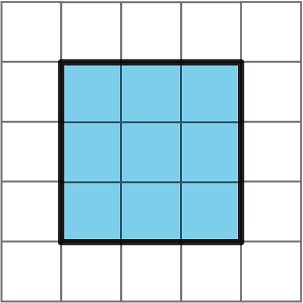Lesson 17Squares and Cubes
Let’s investigate perfect squares and perfect cubes.
Learning Targets:
- I can write and explain the formula for the volume of a cube, including the meaning of the exponent.
- When I know the edge length of a cube, I can find the volume and express it using appropriate units.
17.1 Perfect Squares
-
The number 9 is a perfect square.
Find four numbers that are perfect squares and two numbers that are not perfect squares.

- A square has side length 7 km. What is its area?
- The area of a square is 64 sq cm. What is its side length?
17.2 Building with 32 Cubes
Use the 32 snap cubes in the applet’s hidden stack to build the largest single cube you can. Each small cube has side length of 1 unit.
- How many snap cubes did you use?
- What is the side length of the cube you built?
- What is the area of each face of the built cube? Show your reasoning.
- What is the volume of the built cube? Show your reasoning.
Are you ready for more?
This applet has a total of 64 snap cubes. Build the largest single cube you can.
- How many snap cubes did you use?
- What is the edge length of the new cube you built?
- What is the area of each face of this built cube? Show your reasoning.
- What is the volume of this built cube? Show your reasoning.
17.3 Perfect Cubes
-
The number 27 is a perfect cube.
Find four other numbers that are perfect cubes and two numbers that are not perfect cubes.

- A cube has side length 4 cm. What is its volume?
- A cube has side length 10 inches. What is its volume?
- A cube has side length units. What is its volume?
17.4 Introducing Exponents
Make sure to include correct units of measure as part of each answer.
- A square has side length 10 cm. Use an exponent to express its area.
- The area of a square is sq in. What is its side length?
- The area of a square is 81 m2. Use an exponent to express this area.
- A cube has edge length 5 in. Use an exponent to express its volume.
- The volume of a cube is cm3. What is its edge length?
- A cube has edge length units. Use an exponent to write an expression for its volume.
Are you ready for more?
Lesson 17 Summary
When we multiply two of the same numbers together, such as , we say we are squaring the number. We can write it like this: Because , we write and we say, “5 squared is 25.”
When we multiply three of the same numbers together, such as , we say we are cubing the number. We can write it like this: Because , we write and we say, “4 cubed is 64.”
We also use this notation for square and cubic units.
- A square with side length 5 inches has area 25 in2.
- A cube with edge length 4 cm has volume 64 cm3.
To read 25 in2, we say “25 square inches,” just like before.
The area of a square with side length 7 kilometers is km2. The volume of a cube with edge length 2 millimeters is mm3.
In general, the area of a square with side length is , and the volume of a cube with edge length is .
Glossary Terms
We use the word cubed to mean “to the third power.” This is because a cube with side length has a volume of , or .
In expressions like and , the 3 and the 2 are called exponents. They tell you how many factors to multiply. For example, = , and .
We use the word squared to mean “to the second power.” This is because a square with side length has an area of , or .
Lesson 17 Practice Problems
What is the volume of this cube?

a. Decide if each number on the list is a perfect square.
- 16
- 20
- 25
- 100
- 125
- 144
- 225
- 10,000
b. Write a sentence that explains your reasoning.
-
Decide if each number on the list is a perfect cube.
- 1
- 3
- 8
- 9
- 27
- 64
- 100
- 125
- Explain what a perfect cube is.
-
-
A square has side length 4 cm. What is its area?
-
The area of a square is 49 m2. What is its side length?
-
A cube has edge length 3 in. What is its volume?
-
Prism A and Prism B are rectangular prisms. Prism A is 3 inches by 2 inches by 1 inch. Prism B is 1 inch by 1 inch by 6 inches.
Select all statements that are true about the two prisms.
- They have the same volume.
- They have the same number of faces.
- More inch cubes can be packed into Prism A than into Prism B.
- The two prisms have the same surface area.
- The surface area of Prism B is greater than that of Prism A.
- What polyhedron can be assembled from this net?

- What information would you need to find its surface area? Be specific, and label the diagram as needed.
Find the surface area of this triangular prism. All measurements are in meters.
